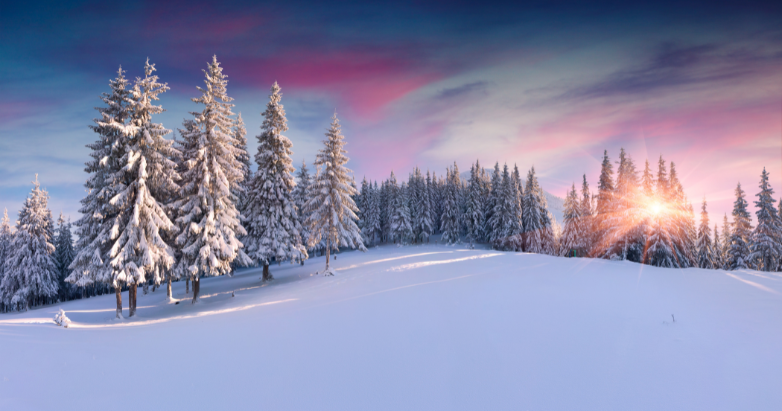Winter is the time of year when the days are growing shorter. The world around us begins to creep into a slower pace. It’s a time when the trees around us are shedding their leaves to preserve their energy and outlast the harsh winter temperatures. Other vegetation may die out or remain dormant throughout the winter, only to reemerge in Spring. During this time, some animals will stockpile food, hibernate, or —if they’re lucky— migrate entirely.
Humans, historically and modern day, do much of the same.

A Witch’s Winter Solstice
Many pagans celebrate the winter solstice, or Yule, which originates from Germanic traditions. Yule stems from the Norse festival, Jol, which had themes of fires and feasts. The modern-day Yule is generally considered an amalgamation of several ancient cultures that held festivities around this time of year.
Saturnalia is another such festival that is thought to contribute to the Yule we know today. Saturnalia was a Roman festival that turned ordinary life on its head. This festival was a period where work halted, and there was merriment and debauchery throughout the lands. Businesses closed, and everyone participated in the festivities. Even enslaved individuals were freed for the duration of the event. Around the same time of year, the Inca Empire celebrated Inti Raymi, a celebration to honor the sun god. The ancient Egyptians also had a similar festival to honor Ra.
The above celebrations are only a few of the many historical cultures that honored this period. Present day, numerous celebrations around the world are held near the winter solstice. This time collectively exudes celebration from all corners of the globe.
In the Northern Hemisphere, the winter solstice takes place around the 21st or 22nd of December. This is the day when the sun is the lowest on the horizon and the shortest day of the year. Many modern pagans and practitioners take this time to spend with their families and loved ones. Winter is a time when a feast will be had and shared. As a further ode to both the old and the arctic temperatures, fires are lit to warm ourselves, our spirits, and usher in a new phase. These fires can be as large as a bonfire or as small as the candle lit on our altar.
Preparing Our Altars and Abodes
An altar is defined as a raised surface intended for worship. For practitioners, this is a sacred space inside or outside our home that can be utilized for both worship and rituals. Some individuals may even have more than one, and each altar can have its own purpose. During Yule, many enjoy decorating their altars for the season. I like to think of my home as an extension of my altar, as both my home and the earth around me are my places of worship. As such, when inviting in the Yuletide season, few surfaces in my home remain untouched.
When searching for decorations, many can be found outdoors. Items like pine cones, sprigs, or needles are great for decorations, cleaning, and spellwork. Pine is wonderful for protection, healing, and drawing prosperity. Cones and sprigs can be placed on the altar, whereas needles can be burned to cleanse your home. Cedar is another excellent addition; its correspondences are also healing, protection, and prosperity. Much like pine, cedar can be used for smoke cleansing. Please remember when doing so, a fire-safe dish is paramount.
Bells are a timeless tool, and they’re great for clearing energy and for protection around the home. Historically, bells were used not only as a form of communication but also to ward off evil spirits. “Witches bells” are common in a witch’s home. These are crafted from circular wreaths featuring dangling bells and hung around the door for protection. These bells are suitable for year-round defense but also fit seamlessly with the season.
Candles are another popular tool, both in historical and modern times. Yuletide candles are traditionally in whites, golds, greens, and reds. These can be placed on your altar or around your home, but they’re also great for spellwork. Full disclosure: as a modern witch, I have been known to grab popular “Christmas” candles to use for not only their aesthetic but their scent correspondences as well. No harm, no foul.
I’ll be enjoying my Balsam-scented candle in peace, regardless.
Crafting Pomanders
Pomanders are a staple of the season and are crafted by piercing the rind of an orange with cloves. The word pomander comes from the French word “pomme d’ambre” which translates roughly to “apple of amber.” ⁶ Historically, these pomanders were used as perfumes that were thought to ward off illnesses such as the Black Plague.⁷ Unfortunately, this was an ineffective antidote.
In modern practices, pomanders can be useful for warding off evils and inviting in success, love, and prosperity. Oranges themselves attract luck, love, and money. Cloves are handy little spices used for protection and exorcism but are also useful for attracting love and prosperity. After dressing the oranges, some practitioners coat them with a mixture of other spices. One common spice used is cinnamon. Cinnamon is a very useful tool in spellcrafting. It can be used for protection, attracting love and success, but it can also be used to quicken a spell’s results. Nutmeg is another commonly used ingredient, and this is also a wonderful spice for protection and prosperity.

Materials:
- 1 Whole Orange
- ½ Cup of Cloves
- (Optional) Cinnamon
- (Optional) Nutmeg
Directions:
- Creating a pomander is relatively easy. All you need to do is pierce the rind of the orange with the cloves. Many like to get crafty with this. Some will shave designs into the rind and add cloves accordingly. This step isn’t necessary, but it can be an opportune time to carve a sigil or a rune into your pomander.
- Mix additional spices such as cinnamon and nutmeg in a dish and roll the pomander in the herb mixture until it’s adequately coated.
- Place items on your altar or around your home. Pomanders typically last around four days, but the additional cinnamon coating can preserve them for a bit longer.
Creating Witches Balls
Witch balls originated in England in the 18th century, but the individuals creating them likely never thought of themselves as practitioners. In fact, their traditional purpose was to ward a home against witches and any corresponding mischief. Witch balls were glass or spherical mirrors that were hung in the corners of a home to guard against curses or other attacks. The thought was that a witch could not stand looking at their reflection and that it would render them incapable of entering the room or doing harm.⁹
Modern-day witchery has done a bit of repurposing, considering we, the witches, are crafting these—but to achieve similar goals. These balls are helpful for warding against negative energies or entities but can also be used to attract positivity as well. Present day, these balls are still primarily made of glass. One of my favorite ways to craft these is a fusion of this concept with Yuletide ornaments.

Materials:
- 1 empty glass or plastic round ornament
- 1 whole cinnamon stick
- 1-2 sprigs of dried cedar
- 1 pinch of dried juniper berries
- 1 pinch of dried rose petals
- 1 pinch of dried lavender
Directions:
- Start by gathering your materials and your ornament. When I am adding my ingredients into a witch ball, I like to assign each component its purpose as I am crafting.
- Add cinnamon for protection and success, cedar for protection and prosperity, juniper berries for protection and good health, rose petals for protection and love, and lavender for protection and peace.
- For a traditional approach, hang this ball in the corner of the room. Alternatively, you can place this item where you see fit.
Witchy Calender Years End
Winter is a time of shedding our old leaves, so to speak. This is a time when we collectively vow to give up old habits and pursue new and improved ones. Soon our social media feeds will be peppered with promises of leaving the past behind as the clock marches toward the new year.
While one may think New Year’s resolutions are a modern construct, this is not the case. New Years’ Resolutions originated with the Babylonians, an ancient, polytheistic civilization, over 4,000 years ago.¹⁰ If they kept their vows, the gods would greatly reward them. While the Babylonians made resolutions in March, our present-day practices were likely subsumed from this tradition.
In modern times, these can often be a period of great pause, leading to introspection and reflection. Businesses may close, or we may cash in our vacation time to retreat from the everyday bustle. It is a time when we break away from our ordinary routines. While the holidays can bring families together, which carries its own brand of chaos, there is still a slower existence in the world around us and our relation to it. This provides us the space to evaluate ourselves and our lives to determine what is working for us versus what is no longer serving us.
Both seasons and life are cyclical, and winter is but one point of the cycle. In the winter season, we are asked to let go of anything that doesn’t align with our current trajectory. In winter, we are in a period of time that asks us to transform. This transformation can be akin to experiencing a death of sorts alongside the world around us. However, winter is only one cycle stop, as vegetation and humans alike will experience a subsequent rebirth.
















